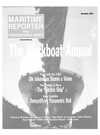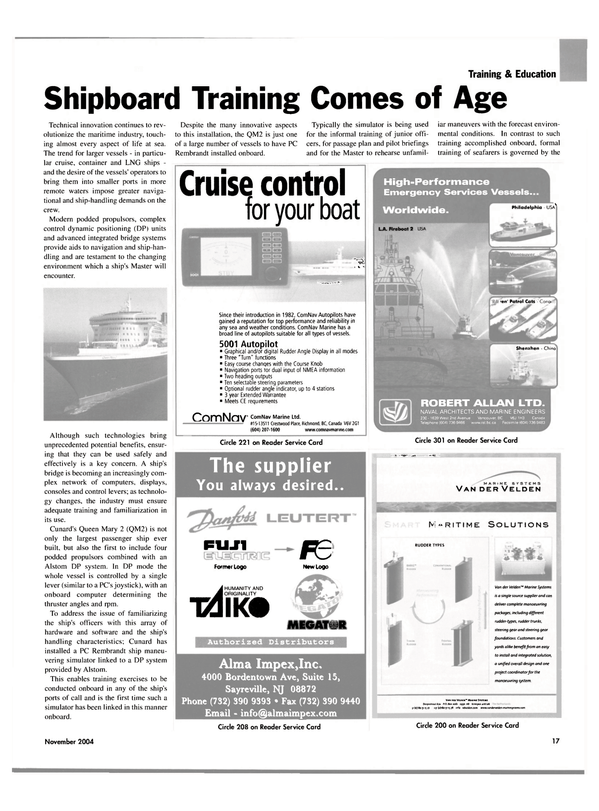
Shipboard Training Comes of Age
Technical innovation continues to revolutionize the maritime industry, touching almost every aspect of life at sea.
The trend for larger vessels - in particular cruise, container and LNG ships - and the desire of the vessels' operators to bring them into smaller ports in more remote waters impose greater navigational and ship-handling demands on the crew.
Modern podded propulsors, complex control dynamic positioning (DP) units and advanced integrated bridge systems provide aids to navigation and ship-handling and are testament to the changing environment which a ship's Master will encounter.
Although such technologies bring unprecedented potential benefits, ensuring that they can be used safely and effectively is a key concern. A ship's bridge is becoming an increasingly complex network of computers, displays, consoles and control levers; as technology changes, the industry must ensure adequate training and familiarization in its use.
Cunard's Queen Mary 2 (QM2) is not only the largest passenger ship ever built, but also the first to include four podded propulsors combined with an Alstom DP system. In DP mode the whole vessel is controlled by a single lever (similar to a PC's joystick), with an onboard computer determining the thruster angles and rpm.
To address the issue of familiarizing the ship's officers with this array of hardware and software and the ship's handling characteristics; Cunard has installed a PC Rembrandt ship maneuvering simulator linked to a DP system provided by Alstom.
This enables training exercises to be conducted onboard in any of the ship's ports of call and is the first time such a simulator has been linked in this manner onboard.
Despite the many innovative aspects to this installation, the QM2 is just one of a large number of vessels to have PC Rembrandt installed onboard.
Typically the simulator is being used for the informal training of junior officers, for passage plan and pilot briefings and for the Master to rehearse unfamiliar maneuvers with the forecast environmental conditions. In contrast to such training accomplished onboard, formal training of seafarers is governed by the requirements of the International Maritime Organization's (IMO's) International Convention on Standards of Training, Certification and Watchkeeping of Seafarers or STCW '95. This has traditionally required seafarers to undertake supervised shore based training and assessments. These formal and informal onboard training methods have traditionally existed and progressed independently.
However, with its new range of computer based training (CBT) products, BMT is seeking to transform the future of maritime training. A new ship maneuvering and handling CBT course, developed in collaboration with the Seattlebased Pacific Maritime Institute, offers a highly interactive learning tool, which provides flexibility as to when and where people study. BMT's CBT is based upon fully approved and accredited course material and is initially designed to complement and reduce the extent of the shore based training component for officers in charge of a navigational watch.
In this manner the remote or 'distance learning' aspect of training can be undertaken at a time and location to suit the student and their employer. Without the travel, venue, accommodation and other associated overhead expenses; a training solution can be provided very cost effectively.
In addition, this type of course material can easily be customized to a client's specific vessel and updated to keep pace with technological and regulatory changes.
Developing courses is only one aspect of the CBT solution; another is how to provide them to trainees. An innovative idea currently being developed by BMT is a concept by which remote training can be centrally coordinated, updated and monitored.
In this proposed system, called SeaTrain, training or information modules will be centrally stored on a server that permits direct access from home users and a 'virtual' direct access from shipboard users.
To address issues of adequate bandwidth and satellite access faced by ships, shipboard users' systems will be linked via the Internet to the central web server and storage facility.
With the SeaTrain concept, all manner of training courses and material can be accessed including specific ship or equipment familiarization material, public health, vessel security, safety and crisis management, regulatory information, company directives and the company's quality management system. The use of a specialized CBT player and modular design will allow components of any course (such as text, audio or graphics) to be easily changed without requiring a costly and time-consuming modification to the entire course.
For ship operators this facility provides advantages for cost and training time reductions. An individual's training or knowledge of company procedures can be tracked and logged and the system itself becomes a multi-functional, flexible and tangible asset.
The pace of change in the maritime sector shows no sign of slowing and training methods must be able to stay a step ahead. E-learning, which has been successfully used in other sectors, presents an opportunity to meet this challenge.
There has already been widespread interest in BMT's developments by companies such as Royal Caribbean International, V. Ships and Princess Cruises.
Circle 13 on Reader Service Card
Read Shipboard Training Comes of Age in Pdf, Flash or Html5 edition of November 2004 Maritime Reporter
Other stories from November 2004 issue
Content
- Austal Launches 417 ft. Aluminum Ship page: 9
- Design Completed for Steamship Authority Ferry page: 9
- Blount to Deliver MV Isleno page: 10
- SF Bay Ferry Logs Impressive Performance page: 11
- NASSCO Holds Ceremony for Fourth BP Tanker page: 12
- K&C Wins $6M Navy Contract page: 12
- Air Emissions from Ships page: 14
- Shipboard Training Comes of Age page: 17
- Demystifying Parametric Roll page: 20
- A Bright Spot in Oil Patch Vessel Construction page: 26
- Senesco Marine Signs Contract For 140,000-Barrel DH ATB page: 30
- Coffee Company Investigates MContainer-on-BargeM Service page: 31
- USCG Invests in Low Engine Exhaust Temps page: 33
- Seacraft Delivers RV Hercules page: 36
- Caterpillar Gets "ACERT"-ive page: 37
- Making the Mark For Crescent Towing's Fleet page: 40
- The New Wartsila 46F page: 41
- Market Vision with Wartsila s Ole Johansson page: 42
- VT Halter Launches PCTC page: 44
- Aluminum Industry Continues Support for the Marine Market page: 46
- Film Celebrates Golden Age of NW Boats page: 47
- Pressure Transmitter Receives ABS Approval page: 48
- Fire Prevention: "Rising" to the Occasion page: 48
- For Those in Peril page: 50
- A Future in Composites page: 52
- Extra Value in Chinese Construction page: 53
- Record Spend on Propulsion? page: 54
- Collaboration Creates Vehicle for CNG Solutions page: 56
- Milestone Reference with MAN B&W page: 58
- The Will for Business page: 58
- Wider Remit for Dutch Matchmaker page: 58
- 2n d Generation Onboard NAPA Tanker Released page: 58
- Nichols Named "Maritime Man of the Year" page: 59
- ACBL Makes Appointments page: 59
- International Paint Japan K.K. - Open for Business page: 60
- European Yard Initiative - Will it Work? page: 62
- A.P. Meller-Maersk Creates Dedicated Tech Group page: 64
- SembCorp Signs Breakthrough, Long Term LNG Deal page: 66
- Keppel Batangas Completes SemiSub Repair page: 68
- A&P Tyne Re-Delivers FPSO Haewene Brim page: 68
- Crane Materials Launches TimberGuard page: 70
- Fincantieri Orders Water- Lubed Shaft Bearings page: 70
- Bilge Water Treatment Unit Approved By LR page: 71
- Electric Propulsion for Coastal Ships page: 72
- ALSTOM Wins $102M Navy Deal page: 73
- Offshore & Marine Chose Vacon AC Drives page: 73
- Successful Full Load Operation of 5-MW Ship Propulsion Motor page: 74
- Innovative Tweendeck Patented in U.S. page: 76
- MAN B&W Records Busy Hamburg Show page: 77
- Transas Demonstrates New Tech at SMM page: 77
- BV Launches Project Management Solution page: 78
- Xantic Offers New Web-Based Tool page: 79
- New AIS Targets U.S. Workboat Market page: 80
- Hepworth Makes a Good Show at SMM page: 80
- New PVC-Free Alternatives for Interior Decoration page: 80
- A High-End Global Satcom Presence page: 82
- IPS Marine Lands New Blue Chip Casino page: 85
- Rigdon Marine Promotes Harkness to CFO Post page: 85
- Tidewater: Effects of New Tax Bill Are Positive page: 86
- Bollinger to Design, Build Five DH Hot Oil Barges page: 87
- B+V Wins Passenger Ship Contract page: 88
- In Remembrance: Captain Fred Kosnac Jr. (1928-2004) page: 92
- Electronic Charting Aboard APL China page: 93
- Electric Boat Optimizes Nuclear Sub Repairs page: 94
- Kramek, Liu Snare Top SNAME Honors page: 97


